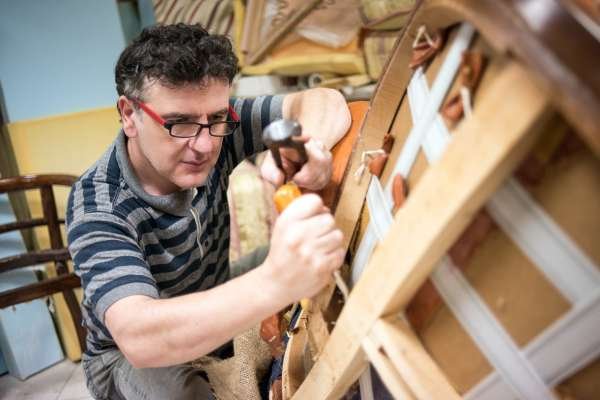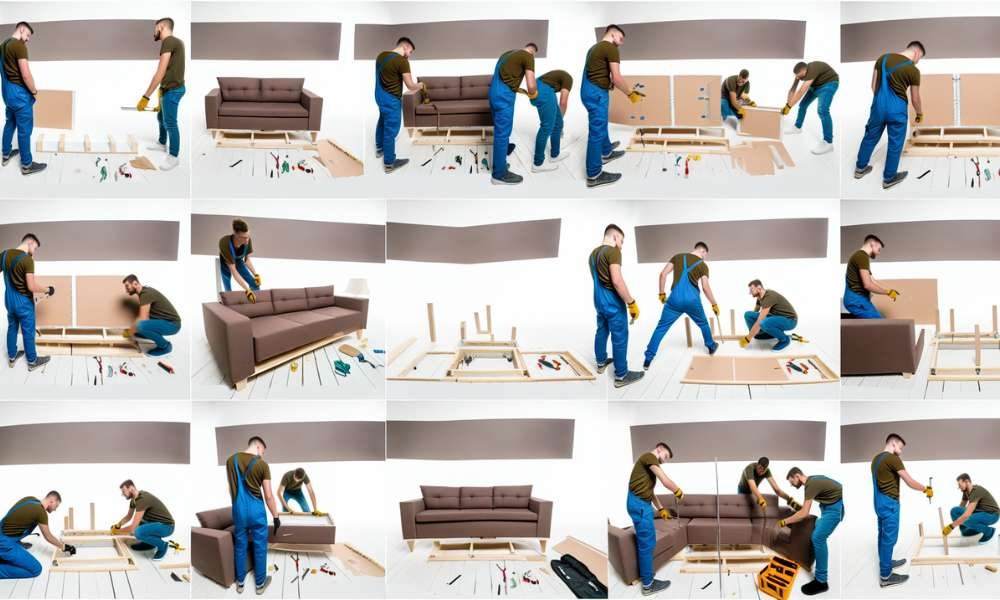Disassembling a sectional couch is crucial for various reasons, including facilitating its movement, enabling thorough cleaning, and providing access for repairs. Whether you’re relocating, deep cleaning, or needing to fix a component, knowing how to disassemble a sectional couch is advantageous. By disassembling the sofa, you can ensure easier transportation during a move, reach and clean often-overlooked areas, and address any maintenance or repair requirements more effectively. This step-by-step guide will equip you with the knowledge and confidence to disassemble your divisional couch efficiently, enabling you to leverage these benefits and maintain your couch in optimal condition.
Preparing for Disassembly

Prepare for disassembling your sectional couch by gathering essential tools like screwdrivers, pliers, and storage bags. These tools will aid in the efficient disassembly of the sofa. Additionally, ensure to clear the area around the divisional couch to allow easy access to all its components. A clutter-free space will make the disassembly process smoother and more manageable. By having the right tools at hand and creating a conducive workspace, you can streamline the disassembly process and set the stage for a successful sectional sofa disassembly.
Understanding the Couch Structure
Understanding the structure of your sectional couch is crucial before initiating the disassembly process. Typical components of a sectional couch include frames, cushions, connectors, and fasteners. These components play a vital role in holding the sofa together and must be carefully addressed during disassembly. Connectors and fasteners, which may include screws, bolts, or clasps, are key elements that secure the sections of the couch. By familiarizing yourself with these components and their functions, you can approach the disassembly process with confidence and precision. This knowledge will enable you to navigate the various connections within the sofa, ensuring a systematic and efficient disassembly.
Removing Cushions and Pillows

When disassembling a sectional couch, it’s essential to begin by removing the cushions and pillows. Labeling these components and storing them in labeled bags is crucial for a seamless reassembly process. Properly labeled cushions and pillows not only ensure easy identification during reassembly but also help maintain the overall integrity of the sofa. By carefully labeling and storing these components, you can streamline the reassembly process and minimize the risk of misplacement or confusion. This organized approach will contribute to a hassle-free and efficient reassembly, allowing you to restore your sectional couch to its original state with ease.
Detaching Sections
When disassembling a sectional couch, detaching the sections requires careful attention to the connectors or fasteners holding them together. Begin by locating these connectors or fasteners, which may include screws, bolts, clasps, or specialized connectors specific to your sofa. Next, provide step-by-step instructions for safely and methodically separating the sections of the couch. This may involve unscrewing fasteners, unclasping connectors, or lifting and separating modular sections, depending on the design of your sectional couch. By understanding the specific mechanisms holding the sections together and following the appropriate disassembly steps, you can effectively detach the sections without causing damage or compromising the structural integrity of the sofa. This systematic approach ensures a smooth disassembly process, setting the stage for successful transportation, cleaning, or repairs.
Disassembling Reclining or Modular Sections
When disassembling a sectional couch, special attention must be given to reclining or modular sections, if applicable. Detail the process for disassembling these sections, taking into account any unique features or mechanisms they may possess. This could include explaining how to disconnect the reclining mechanisms or separate modular components in a manner that ensures the safety and integrity of the sofa. Address specific considerations for these types of sectional couches, such as the removal of electrical components for reclining sections or the disassembly of interlocking modular segments. By providing clear and detailed guidance for these specialized sections, you can ensure a comprehensive disassembly process that covers all aspects of your divisional sofa, enabling a successful and efficient disassembly experience.
Dealing with Sectional Sofa Beds

When disassembling a sectional couch with a sofa bed feature, it’s important to provide guidance on how to disassemble the sofa bed component. This may involve addressing specific steps for removing the mattress, releasing the locking mechanism, and separating the bed frame from the rest of the sofa. Additionally, it’s crucial to address any unique challenges associated with divisional sofa beds, such as managing the weight and bulkiness of the bed frame or handling any mechanical components. By offering clear instructions tailored to the disassembly of sectional sofa beds, you can help individuals navigate the process with confidence and ensure that all aspects of the sofa, including its bed feature, are properly and safely disassembled. This comprehensive approach will contribute to a successful disassembly experience for sectional couch owners.
Handling Large or Heavy Components
When disassembling a sectional couch, handling large or heavy components requires careful consideration for safety and efficiency. Offer tips for safely lifting and moving heavy components, emphasizing the use of proper lifting techniques to avoid strain or injury. Additionally, recommend the use of furniture sliders or other equipment to facilitate the movement of large and heavy sections, reducing the physical effort required during disassembly. By incorporating these recommendations, individuals can navigate the disassembly process with greater ease, minimizing the risk of accidents or strain. This approach not only promotes safety but also contributes to a smoother and more manageable disassembly experience, allowing sectional couch owners to proceed with confidence and peace of mind.
Storing Disassembled Parts
When disassembling a sectional couch, it’s crucial to advise on best practices for storing and organizing the disassembled components. Recommending the use of labeled containers or bags for smaller parts and components and allocating a dedicated storage area for larger sections will aid in maintaining organization and ease of reassembly. Additionally, suggesting the use of protective coverings, such as furniture blankets or plastic wraps, will help prevent damage to the disassembled parts during storage or transportation. By following these storage best practices, individuals can safeguard the components of their sectional couch, ensuring that they remain in optimal condition for the duration of the disassembly process and beyond.
Reassembly Considerations
When considering reassembly after disassembling a sectional couch, it’s crucial to stress the importance of keeping track of hardware and connectors. Emphasize the need to organize and store these components carefully to prevent loss or confusion during the reassembly process. Additionally, encourage individuals to refer to the manufacturer’s instructions for specific reassembly guidance, ensuring that the sectional sofa is reconstructed accurately and securely. By highlighting the significance of maintaining hardware and following the manufacturer’s guidelines, individuals can approach the reassembly phase with confidence and precision, ultimately leading to a successful restoration of their sectional couch to its original form. This proactive approach contributes to a seamless reassembly process, enabling individuals to enjoy their divisional sofa once again.
Cleaning and Maintenance Opportunities

As you disassemble your sectional couch, take advantage of the opportunity to refresh and maintain its individual sections. Cleaning and performing maintenance during this process can help prolong the lifespan of your sofa. For fabric sections, consider vacuuming or using a fabric cleaner, while leather sections may benefit from a specialized leather cleaner and conditioner. Microfiber sections can be gently cleaned with a microfiber cloth and mild soap. By tending to each section’s specific needs, you can ensure that your sectional couch remains in top condition for years to come. This proactive approach not only improves the cleanliness of your sofa but also contributes to its overall aesthetic appeal and durability.
Conclusion
In conclusion, when disassembling a sectional couch, it’s essential to follow key steps and considerations to ensure a successful process. Begin by carefully labeling and organizing components, keeping track of hardware and connectors, and referring to the manufacturer’s instructions for reassembly guidance. Utilize this opportunity to clean and perform maintenance on individual sections, tailoring the approach to the specific materials used in the sofa. As you proceed, prioritize the protection of disassembled parts by using protective coverings during storage or transportation. Lastly, encourage readers to share their experiences and seek professional help if needed, as dismantling and reassembling a divisional couch can be a complex task. By sharing insights and reaching out for assistance when necessary, individuals can navigate the process with confidence and expertise, ensuring the successful disassembly and reassembly of their sectional couch.
